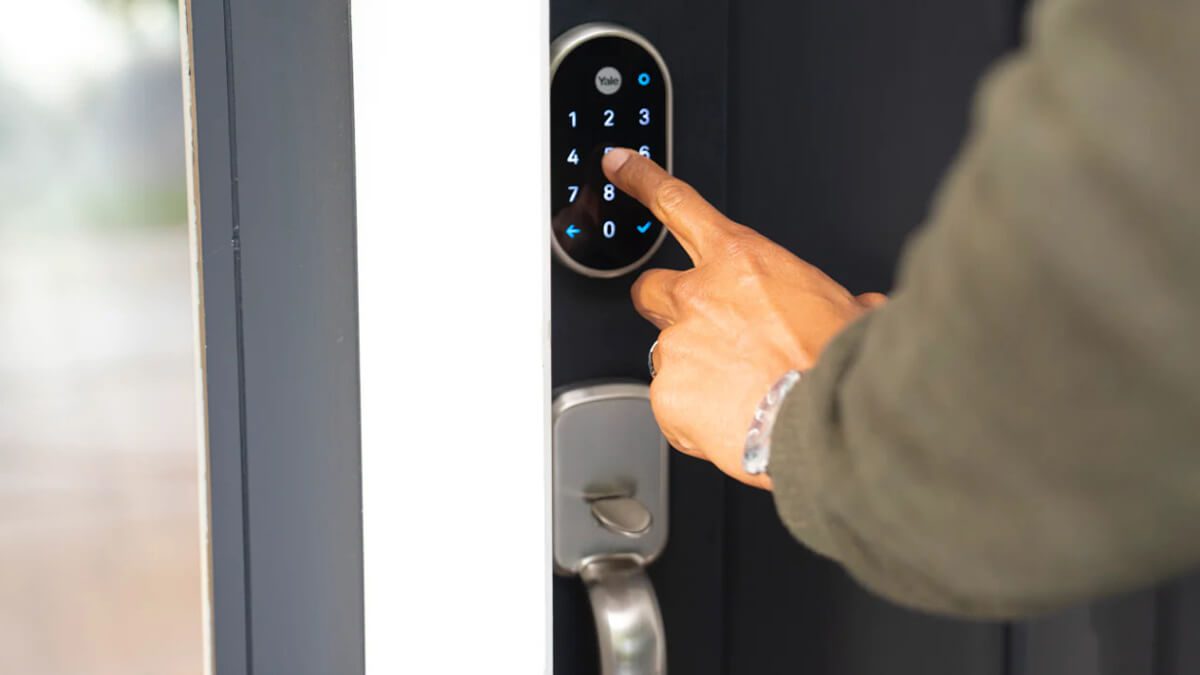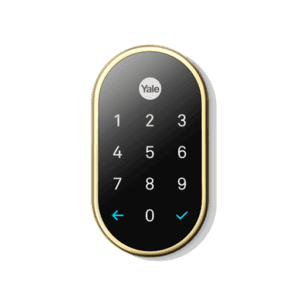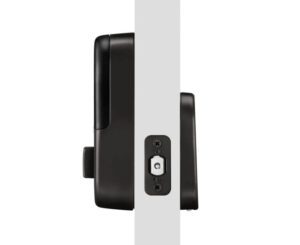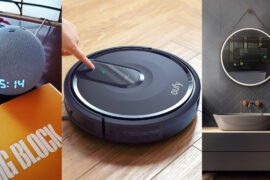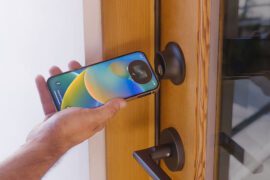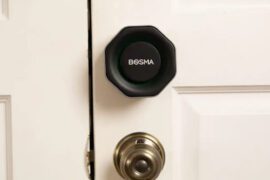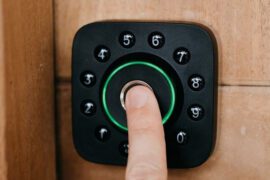The Nest x Yale lock is well-designed and user-friendly, making it the ideal option for people who appreciate Nest’s ecosystem. Nonetheless, if you are already integrated into a different smart home ecosystem, there might be a more suitable alternative available.
REASONS TO BUY
- Elegant, sleek design
- Works perfectly within the Nest ecosystem
- Easy to install and use
- Simple to use the app
- Simple keypad and app-powered operation
- Responsive and reliable
- Works with Google Assistant
- Integrates with other Nest device
REASONS TO AVOID
- Expensive
- Lack of compatibility with ZigBee, Z-Wave, or iM1 (HomeKit) modules for smart home integration.
- Remote access sharing often malfunctions
- No physical key backup
- Large rear lock housing
Design and Compatibility
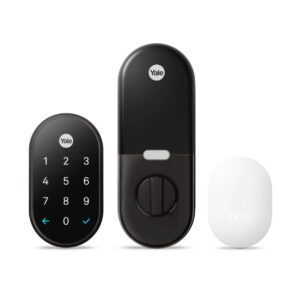
The Nest x Yale Lock is designed to replace your current deadbolt, offering a convenient upgrade. Similar to the tested Yale Assure Lock 2, this smart lock from Yale maintains the keyless feature and stylish design. It is available in polished brass, oil-rubbed bronze, or satin nickel finishes. The lock includes comprehensive printed instructions and a helpful installation app called Bilt, which ensures a smooth setup process.
Before purchasing any lock, it is crucial to ensure compatibility with your door. The Nest x Yale Lock is compatible with most wood, metal, and fiberglass doors. However, it is not suitable for sliding doors, glass doors, Mortise locks, or multipoint locks. Additionally, you need to consider the backset of your door, which refers to the distance between the edge of the door and the center of the deadbolt hole. If your deadbolt is more than 2.75 inches away from the door’s edge, it is not compatible with this particular lock.
Installation
The installation process is similar to other smart locks and fairly straightforward
- Attach the front plate of the lock.
- Connect the cable from the front plate to the receptor on the interior piece of the lock.
- Install the interior piece of the lock
- Insert the batteries.
After the installation of the smart lock, the lock’s side speaker will play a welcome message, followed by a prompt to enter a master code.
In addition, you should calibrate the door by closing it when it’s unlocked, enabling the deadbolt to evaluate its motorized locking mechanism. If you encounter difficulty in fully closing the door without exerting extra pressure or force, it could indicate potential challenges during the installation of a new lock.
Before installing the lock, it is advisable to address any problems with the door hinge or frame. After completing the master code setup and calibration, you can proceed to connect it with your existing Nest products by following the instructions provided in the Nest app.
PS: The customization options for this lock closely resemble the options found in other Yale locks.
You can :
- Adjust the speaker volume and language.
- Create and edit passcode settings from the keypad or the Nest app.
- Enable the auto relock option from the keypad or the app.
The Nest App
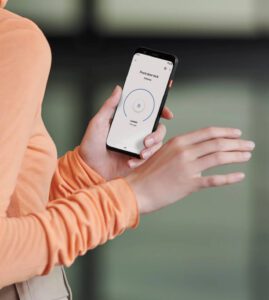
By connecting the Nest × Yale Lock to your Nest app, you gain the convenience of remotely locking and unlocking your door using your phone. Moreover, you have the ability to generate up to 20 passcodes for your friends and family and receive notifications whenever any of these passcodes are utilized. You can even set expiration dates and times for these passcodes.
In addition, the Nest x Yale Lock offers the feature of receiving alerts whenever the door is manually locked or unlocked, if there is any tampering, or if someone attempts an incorrect password five times. The accompanying app also incorporates Home/Away Assist, which automatically locks your door when the rest of your Nest system (such as your thermostat or doorbell) detects your absence.
Nest x Yale Lock Smart Features
The Nest x Yale lock exclusively operates with the Nest app, lacking compatibility with platforms like Alexa and Google Assistant. Although this could change in the future due to software updates, currently, it remains a device solely designed for Nest integration.
Controlling the lock through the Nest app is convenient and effective. It allows you to set keycodes, remotely lock and unlock the door, and view a comprehensive activity log. If your primary requirement is a smart lock with remote app control, the Nest x Yale would be a valuable addition to your home.
However, the smart features of the Nest x Yale encounter challenges when it comes to remote access sharing. Most sharing functions rely on the app, necessitating recipients to have both a Nest account and the app. While these are free, it becomes inconvenient when granting access to new individuals such as dog walkers or babysitters. Additionally, despite the app enabling easy creation of time-constrained keypad codes for sharing with other Nest app users, we experienced frequent issues. Approximately 50% of the time, the app failed to generate a keycode, resulting in no shared access.
There are a couple of workarounds for these sharing problems. First, you can create a new keycode and simply text it to the intended person. However, this method lacks the ability to set time constraints, granting continuous access until the code is deleted. While this may work with diligent manual code management, it lacks the desired smart functionality. Another option is to remotely lock or unlock the door upon receiving a text message from someone at the door, requiring user intervention within the app. However, this approach also lacks a seamless smart experience.
Keyless Entry
The Nest x Yale offers two methods to open the lock without a key. The first is by entering a keypad code, while the second involves using the Nest app on your phone to unlock it with a button press. Both methods proved effective during our testing, but we found entering a keycode more convenient than dealing with a phone, except when carrying numerous groceries. In such cases, the app can be useful to unlock the door from the car before loading your arms with groceries.
Ironically, the Nest x Yale falls short of a top score in this category due to the absence of a physical key option. While this enhances security against lock picking, it also means being locked out if the lock’s battery dies. In such situations, a temporary solution is to connect a 9-volt battery from the outside to provide power to the lock. However, this process feels more cumbersome compared to simply keeping a spare key hidden in the glove compartment for occasions when the lock’s battery depletes.
Nest x Yale Lock and Nest Hello Doorbell
One of the more intriguing features of this lock is its compatibility with the Nest Secure alarm system. In principle, you can activate a setting in the Nest app that disarms your alarm when the door is unlocked. However, we haven’t had the opportunity to test this feature yet, as it’s still in the process of being rolled out to all consumers. We will provide an update once this functionality becomes available.
I was filled with anticipation when considering the integration of the Nest Hello doorbell and the Nest x Yale Lock. However, in reality, the level of integration is rather limited. While the two devices coexist within the Nest app, their communication capabilities are relatively restricted. If you have a Nest Hello doorbell, the Nest app will notify you of visitors at the door and present a live video feed. You can engage in two-way audio communication or navigate to the lock section within the app to unlock the door. However, due to security measures, the Nest Hello doorbell doesn’t employ its Familiar Faces recognition feature to automatically unlock the door for homeowners
Nest x Yale Lock Battery
The Nest x Yale Lock operates using four AA alkaline batteries. When the battery level starts to decrease, the Nest app sends an alert, and a red low battery light illuminates the lock’s keypad. Additionally, an audible alert accompanies the use of the keypad.
In case you overlook the initial warnings (as many of us tend to do), you will receive another notification when the batteries reach a critically low level. If the batteries eventually die, the lock provides terminals on the bottom where you can connect a 9V alkaline battery for emergency access, as mentioned earlier. You can then enter your passcode and unlock the door.
Nest technology
The Nest x Yale Lock doesn’t directly connect to Wi-Fi but instead utilizes Weave, Nest’s wireless smart home communication technology. To enable connectivity with the Nest service in the cloud and the Nest app on your iOS or Android device, you’ll need either a Nest Connect module or a Nest Guard unit. These units connect to your Wi-Fi network and facilitate communication between your lock and the Nest ecosystem.
It’s worth noting that incorporating an additional module, such as the Nest Connect, to enable remote access is a common practice among smart lock manufacturers. Other brands like Kwikset and August also offer their own versions of these modules.
What You’ll Be Missing Out On
The Nest line of products effectively facilitates interaction and information sharing among its devices. However, it lacks smart home integrations outside of the Nest ecosystem. Unlike the Yale assure lock 2 we tested, the Nest x Yale model does not offer options for a Z-Wave, ZigBee, or iM1 (HomeKit) module. As a result, it cannot be used with SmartThings, HomeKit, or other smart home hubs. Control over the lock is limited to the Nest app and the Nest platform.
Currently, voice-assistant compatibility is still being developed. The lock does not support voice control at the moment, but the Nest team has expressed their desire to integrate with Google Assistant in the future. This integration would enable users to check if their door is locked or lock it using voice commands. This may be disappointing considering Google’s recent enthusiasm for incorporating AI into Nest products after Nest joined the Google umbrella. It is worth noting that Yale’s Real Living line of locks has offered voice commands since last July.
If voice compatibility is implemented, the Nest x Yale Lock would compete with brands like August and Schlage, whose locks already support voice assistants for such commands. However, there are no plans to enable voice control for unlocking the Nest x Yale Lock, as most smart lock manufacturers agree on restricting this feature for security reasons.
Nest x Yale Lock Security
The Nest x Yale Lock receives a classification of ANSI Grade 2, surpassing the minimum security requirements for residential locks but not meeting the standards set for commercial locks. Moreover, it provides the convenience of configuring auto-locking with a customizable delay. Unlike standard locks that automatically lock after 30 seconds of inactivity, the Nest x Yale Lock allows you to adjust the timing according to your preference. This feature guarantees that you won’t experience accidental lockouts when making a quick trip to retrieve the mail. In our testing, we observed the auto-locking feature to be extremely reliable, without encountering any instances of failure.
Should You Buy the Nest x Yale?
Smart locks, including the Nest x Yale Lock, generally come with a higher price tag compared to traditional “dumb locks,” especially when factoring in the additional cost of a smart home hub in some cases. However, if you have already made investments in other Nest products, the integration of the Nest x Yale Lock with your existing system adds value and enhances its usability.
What Other Smart Locks Should You Consider?
While the Nest x Yale Lock is functional, it falls short of greatness. It has some glitches, particularly when it comes to code sharing. However, if you have already invested in the Nest ecosystem and desire remote lock monitoring, it can still be a worthwhile purchase. On the other hand, if this is your initial venture into smart home technology, we highly recommend considering the August WiFi Smart lock instead. It offers better integration with multiple hubs, boasts user-friendly features, and provides a more affordable option.
How to Buy
When purchasing the Nest x Yale Lock from prominent retailers like Best Buy, Home Depot, Target, or Lowe’s, the bundled package priced at $279 includes the Nest Connect. However, if you decide to buy the Nest Connect separately, it will cost you $69, making the bundled package a favorable deal. On the other hand, if you choose to purchase the Nest x Yale Lock directly from Nest’s website, you have the option to buy only the lock itself for $249. If you already own a Nest Guard, there is no need to acquire the Nest Connect separately.
THE BOTTOM LINE
If you are a fan of Nest products, particularly if you already own the Nest Secure alarm system, the Nest x Yale smart lock is a reliable choice. However, if you prioritize voice control or desire more versatile integration with smart-home hubs, it would be advisable to explore other options.
Other Articles You Might Like
Other Articles You Might Like
- The Best Smart Locks 2023
- Yale Assure Lock 2 Review: A Game-Changer in Home Security
- August Wi-Fi Smart Lock review
FAQs:
Starting from April 8, 2024, Nest will discontinue its support for Nest Secure. Consequently, the Nest Secure system will no longer be accessible through the Nest app and will lose its internet connectivity. As a result, you will no longer have the ability to use the Nest app to monitor the status of your Nest Secure, manage your Nest Secure devices, or receive alarm system notifications.
Read more!
The Nest x Yale Lock requires Wi-Fi for remote access and control through the Nest app. Basic manual locking and unlocking are possible without an internet connection.
Yes, the Nest x Yale Lock is battery-powered. It uses four AA batteries as its power source.
The Nest x Yale Lock’s batteries typically last around one year under normal usage conditions.
No, Yale Lock is not owned by Google. However, Yale Lock and Nest (a company owned by Google) collaborated to create the Nest x Yale Lock, combining Yale’s expertise in lock hardware with Nest’s smart home technology.

